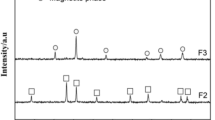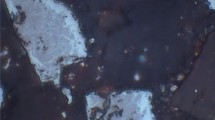Abstract
Hydrogen-based direct reducing iron production (H-DRI) possesses great potential for energy saving and emission reduction of greenhouse gas in metallurgical industries. Although the relevant research has been studied since long, the thermodynamics and process of reduction by pure H2 in a broad temperature range are not well understood. Hence, we conducted a thermodynamic analysis of different iron ores (hematite and magnetite) reduced by H2 at 300–1700 K to study the phase-composition variation with temperature. Subsequently, we explored the reduction process of iron ores by pure H2 at 1173 K and 1673 K, respectively, to further investigate the influence of ore species and temperature on the microstructure evolution of ultimate metallic iron. The results reveal that excessive H2 favors the transition from FeO to Fe in the last reduction step, and the magnetite achieves a higher reduction extent than hematite. Temperature above 837 K is beneficial for avoiding the occurrence of the disproportionation reaction and promoting the FeO → Fe transition to improve the reduction extent. Meanwhile, the higher volume mismatch and the associated stresses between hetero-phases at 1673 K contributed to the formation of large-size pores or cracks. The higher content of dense Fe layers formed in magnetite at relatively lower temperature served as barriers against the diffusion of O, leading to the retention of abundant closed pores in the iron matrix. The oxide impurities cannot be reduced by H2 at 1673 K instead translated into oxide inclusions due to their low oxide-formation free energies, of which the coagulation was facilitated by increasing temperature as the higher velocity of migration and movement. With this study, we aim to provide theoretical direction for the practical application development of H-DRI.









Similar content being viewed by others
References
Nduagu EI, Yadav D, Bhardwaj N, Elango S, Biswas T, Banerjee R, Rajagopalan S (2022) Comparative life cycle assessment of natural gas and coal-based directly reduced iron (DRI) production: a case study for India. J Clean Prod 347:131196. https://doi.org/10.1016/j.jclepro.2022.131196
Cavaliere P (2019) Direct reduced iron: most efficient technologies for greenhouse emissions abatement: clean ironmaking and steelmaking processes. Springer, Switzerland
Contreras W, Hardy C, Tovar K, Piwetz AM, Harris CR, Tullos EE, Bymaster A, McMichael J, Laurenzi IJ (2021) Life cycle greenhouse gas emissions of crude oil and natural gas from the Delaware Basin. J Clean Prod 328:129530. https://doi.org/10.1016/j.jclepro.2021.129530
Tang J, Chu MS, Li F, Zhang ZD, Tang YT, Liu ZG, Yagi J (2021) Mathematical simulation and life cycle assessment of blast furnace operation with hydrogen injection under constant pulverized coal injection. J Clean Prod 278:123191. https://doi.org/10.1016/j.jclepro.2020.123191
Sarkar S, Bhattacharya R, Roy GG, Sen PK (2018) Modeling MIDREX based process configurations for energy and emission analysis. Steel Res Int 89:1700248. https://doi.org/10.1002/srin.201700248
Safarian J (2021) Duplex process to produce ferromanganese and direct reduced iron by natural gas. ACS Sustain Chem Eng 9:5010–5026. https://doi.org/10.1021/acssuschemeng.0c08462
Yilmaz C, Turek T (2017) Modeling and simulation of the use of direct reduced iron in a blast furnace to reduce carbon dioxide emissions. J Clean Prod 164:1519–1530. https://doi.org/10.1016/j.jclepro.2017.07.043
Abd Rashid RZ, Salleh HM, Ani MH, Yunus NA, Akiyama T, Purwanto H (2014) Reduction of low grade iron ore pellet using palm kernel shell. Renew Energ 63:617–623. https://doi.org/10.1016/j.renene.2013.09.046
Guo DB, Zhu LD, Guo S et al (2016) Direct reduction of oxidized iron ore pellets using biomass syngas as the reducer. Fuel Process Technol 148:276–281. https://doi.org/10.1016/j.fuproc.2016.03.009
Weiland F, Nordwaeger M, Olofsson I, Wiinikka H, Nordin A (2014) Entrained flow gasification of torrefied wood residues. Fuel Process Technol 125:51–58. https://doi.org/10.1016/j.fuproc.2014.03.026
Ma Y, Souza Filho IR, Bai Y et al (2022) Hierarchical nature of hydrogen-based direct reduction of iron oxides. Scr Mater 213:114571. https://doi.org/10.1016/j.scriptamat.2022.114571
Souza Filho IR, Springer H, Ma Y, Mahajan A, da Silva CC, Kulse M, Raabe D (2022) Green steel at its crossroads: hybrid hydrogen-based reduction of iron ores. J Clean Prod 340:130805. https://doi.org/10.1016/j.jclepro.2022.130805
He K, Zheng Z, Chen HS, Hao WP (2021) Reduction behaviors of hematite to metallic iron by hydrogen at low temperatures: energy technology. Springer, Cham
Pineau A, Kanari N, Gaballah I (2006) Kinetics of reduction of iron oxides by H2: part I: low temperature reduction of hematite. Thermochim Acta 447:89–100. https://doi.org/10.1016/j.tca.2005.10.004
Khawam A, Flanagan DR (2006) Solid-state kinetic models: basics and mathematical fundamentals. J Phys Chem B 110:17315–17328. https://doi.org/10.1021/jp062746a
Spreitzer D, Schenk J (2019) Reduction of iron oxides with hydrogen—a review. Steel Res Int 90:1900108. https://doi.org/10.1002/srin.201900108
Zuo HB, Wang C, Dong JJ, Jiao KX, Xu RS (2015) Reduction kinetics of iron oxide pellets with H2 and CO mixtures. Int J Min Met Mater 22:688–696. https://doi.org/10.1007/s12613-015-1123-x
Chen F, Mohassab Y, Jiang T, Sohn HY (2015) Hydrogen reduction kinetics of hematite concentrate particles relevant to a novel flash ironmaking process. Metall Mater Trans B 46:1133–1145. https://doi.org/10.1007/s11663-015-0332-z
Piotrowski K, Mondal K, Lorethova H, Stonawski L, Szymański T, Wiltowski T (2005) Effect of gas composition on the kinetics of iron oxide reduction in a hydrogen production process. Int J Hydrog Energy 30:1543–1554. https://doi.org/10.1016/j.ijhydene.2004.10.013
Piotrowski K, Mondal K, Wiltowski T, Dydo P, Rizeg G (2007) Topochemical approach of kinetics of the reduction of hematite to wüstite. Chem Eng J 131:73–82. https://doi.org/10.1016/j.cej.2006.12.024
Pineau A, Kanari N, Gaballah I (2007) Kinetics of reduction of iron oxides by H2: Part II. Low temperature reduction of magnetite. Thermochim Acta 456:75–88. https://doi.org/10.1016/j.tca.2007.01.014
Kim SH, Zhang X, Ma Y et al (2021) Influence of microstructure and atomic-scale chemistry on the direct reduction of iron ore with hydrogen at 700 °C. Acta Mater 212:116933. https://doi.org/10.1016/j.actamat.2021.116933
Feilmayr C, Thurnhofer A, Winter F, Mali H, Schenk J (2004) Reduction behavior of hematite to magnetite under fluidized bed conditions. ISIJ Int 44:1125–1133. https://doi.org/10.2355/isijinternational.44.1125
Zieliński J, Zglinicka I, Znak L, Kaszkur Z (2010) Reduction of Fe2O3 with hydrogen. Appl Catal A Gen 381:191–196. https://doi.org/10.1016/j.apcata.2010.04.003
Martin M (2005) Diffusion in oxides: diffusion in condensed matter. Springer, Berlin
Barde AA, Klausner JF, Mei R (2015) Solid state reaction kinetics of iron oxide reduction using hydrogen as a reducing agent. Int J Hydrog Energy 41:10103–10119. https://doi.org/10.1016/j.ijhydene.2015.12.129
Wang YD, Hua XN, Zhao CC, Fu TT, Li W, Wang W (2017) Step-wise reduction kinetics of Fe2O3 by CO/CO2 mixtures for chemical looping hydrogen generation. Int J Hydrog Energy 42:5667–5675. https://doi.org/10.1016/j.ijhydene.2017.01.159
Sabat KC, Paramguru RK, Mishra BK (2017) Reduction of oxide mixtures of (Fe2O3+CuO) and (Fe2O3+Co3O4) by low-temperature hydrogen plasma. Plasma Chem Plasma Process 37:979–995. https://doi.org/10.1007/s11090-017-9818-6
Ellingham HJT (1944) Reducibility of oxides and sulphides in metallurgical processes. J Soc Chem Ind 63:125–160. https://doi.org/10.1002/jctb.5000630201
Acknowledgements
This work was financially supported by the National Natural Science Foundation of China (U1908227, U1860205 and 52172023), the Key Program of Natural Science Foundation of Hubei Province (2021CFA071), the Special Project of Central Government for Local Science and Technology Development of Hubei Province (2019ZYYD076).
Author information
Authors and Affiliations
Corresponding author
Ethics declarations
Conflict of interest
The authors declare that they have no conflict of interest.
Additional information
Handling Editor: Catalin Croitoru.
Publisher's Note
Springer Nature remains neutral with regard to jurisdictional claims in published maps and institutional affiliations.
Rights and permissions
Springer Nature or its licensor (e.g. a society or other partner) holds exclusive rights to this article under a publishing agreement with the author(s) or other rightsholder(s); author self-archiving of the accepted manuscript version of this article is solely governed by the terms of such publishing agreement and applicable law.
About this article
Cite this article
Li, S., Gu, H., Huang, A. et al. Thermodynamic analysis and experimental verification of the direct reduction of iron ores with hydrogen at elevated temperature. J Mater Sci 57, 20419–20434 (2022). https://doi.org/10.1007/s10853-022-07855-9
Received:
Accepted:
Published:
Issue Date:
DOI: https://doi.org/10.1007/s10853-022-07855-9




